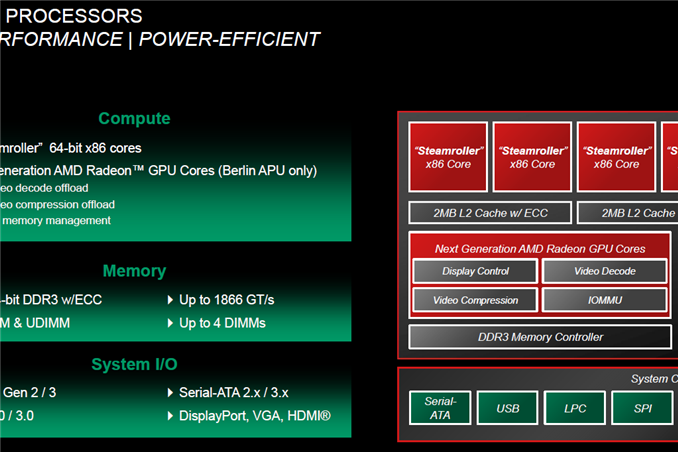AMD Evolving Fast to Survive in the Server Market Jungle
by Johan De Gelas on June 18, 2013 6:00 AM EST- Posted in
- AMD
- CPUs
- Arm
- Enterprise

There are two important trends in the server market: it is growing and it is evolving fast. It is growing fast as the number of client devices is exploding. Only one third of the world population has access to the internet, but the number of internet users is increasing by 8 to 12% each year.
Most of the processing happens now on the server side (“in the cloud”), so the server market is evolving fast as the more efficient an enterprise can deliver IT services to all those smartphones, tablets and pcs, the higher the profit margins and the survival chances.
And that is why there is so much interest in the new star, the “micro server”.
The Demand for Micro-Servers
The demand for very low power server is, although it is high on the hype curve, certainly not imaginary. When you run heterogeneous workloads, for example a mailserver, an OLAP database and several web and fileservers, some of these workloads will be demanding heavy processing power, others will be close to idle. In that case it is best to buy a dual "large core" CPU (or better) server, install a hypervisor and cut the machine up in resource pools. As one workload demands high processing power, your hardware and hypervisor will deliver it. Single thread performance will determine for a large part whether a complex SQL query is responded in a fraction of a second or several seconds. The virtualization layer gives you extra bonuses such as high availability, no more unplanned downtime etc.
If your web based workloads are very homogenous and you know how much horsepower your webapplication needs, things are very different. The virtualization layer is just adding complexity and cost now. In this case it is a lot more efficient to scale out than to divide your heavy server into virtual machines. The single thread performance has to be good enough to respond to a request quickly enough. But throughput demands can be handled by adding a load balancer in front of low power servers. It is much easier to scale this way.
The problem is that the your average server is not well suited for these kind of homogenous workloads. Yes, servers have become a lot more efficient by including advanced power management features. The introduction of CPU C-states and more efficient PSUs are among the top of technologies that saved a lot of power. However, even the most modern servers are still needlessly complex with lots of disk, network and other interfaces. A useless interface wastes a few hundred of mwatt and a less efficient PHY (Copper 10 Gbit Ethernet for example) wastes a few Watt, but in the end it adds up.











80 Comments
View All Comments
JohanAnandtech - Tuesday, June 18, 2013 - link
thx. fixed :-)Denithor - Tuesday, June 18, 2013 - link
"It is clear that the micro server market gets the lionshare of AMD’s attention."lion's share
"While the Opteron-X, Opteron 6300 and “Berlin” CPU will all face stiff completion from the Intel alternatives."
competition
"but it looks like Intel will probably have the upperhand in most traditional server markets."
upper hand
Wow, did you guys not edit this piece before going live?
JohanAnandtech - Tuesday, June 18, 2013 - link
To be honest, I wrongly assumed that I still had some time left, then discovered that the deadline was already a few hours ago and just hurried. So I humbly thank you for making this article more readable for our readers :-)JDG1980 - Tuesday, June 18, 2013 - link
I'm hoping we will see some relatively inexpensive Mini-ITX Kyoto boards. An Opteron-X paired with ECC RAM could make a good, reliable platform for a DIY firewall or low-end NAS.iwod - Tuesday, June 18, 2013 - link
I didn't known the 9W for X1150 was for 1Ghz Core. If so i guess Intel will have Zero competition for Atom Servers. Intel will want to get as much market shares between now to end of 2014 when ARM will have a low power server product. Seattle seems interesting, I wonder if it is possible to have 4x 16 Core Seattle in a server. Seems like a good candidate for Hosting environment.SuperMecha - Tuesday, June 18, 2013 - link
Remember that the X1150 has 4 cores vs the 2 for the Atom chip. It also has much better IPC and support for ECC and 32GB (DDR3-1600) of RAM vs only 8GB (DDR3-1333) for the S1260.JDG1980 - Tuesday, June 18, 2013 - link
The Centertron (S1200-series) Atoms already have ECC support. But the performance is still subpar, so AMD will have an advantage there. Also, as far as I have been able to determine, there is only one Centertron board available to DIYers (the Supermicro X9SBAA-F) and it's hard to find and quite pricey (>$250). If AMD could get Mini-ITX Kyoto boards out at the $150-$200 price point, this would be a quite attractive option for small servers.iwod - Tuesday, June 18, 2013 - link
So how would next Gen Intel Arch compared to Jaguar? Since Intel has ( I think ) Hyper Threading in their Next Gen as well, so a Dual Core isn't so far off from Quad Core, And it seems Intel can ups the Ghz a bit more then the X1150.I would love to see some comparison done.
milli - Tuesday, June 18, 2013 - link
"Berlin will use the same 28 nm process technology as the Opteron x1150 and x2150"Jaguar is made at TSMC.
Rumors for Steamroller derived processors point to production at Globalfoundries. Most go as far as claiming that it will be FD-SOI (see STMicroelectronics). That makes sense because 28nm bulk would be a step back compared to 32nm SOI. I don't think AMD is going to stop using SOI for their high-end CPU's anytime soon.
Either way, be sure that they won't be using the same process technology (even though they're both 28nm) for these very different CPU's.
rocketbuddha - Thursday, June 20, 2013 - link
Please...AMD specifically said in the DEC 2012 WSA amendment with Global Foundries. It is in Page 6 of the 11 Page PDF titles
<quote>
Separately, AMD will move to standard 28nm process technology and significantly reduce reimbursements to GF for future research and development costs.
–
We anticipate these savings will be approximately ~$20M per quarter during the next several years which also helps achieve our OPEX target of $450M by Q3 2013
<end quote>
Read again and again. The standard technology at 28nm is Bulk HKMG. not SOI.
Even GF's powerpoint roadmap states that the 20nm as well as 14XM process will both be successors to 28nm Bulk HKMG will continue to be Bulk HKMG and bulk with FinFETs respectively. And the SOI line stops with 28nm FD-SOI (in collaboration with STM) and just a ambiguous dotted line for the future.
With FDSOI we still do not know if GF has agreed to manufacture FDSOI parts in large volume. All we know is the license agreement between ST Micro and GF.